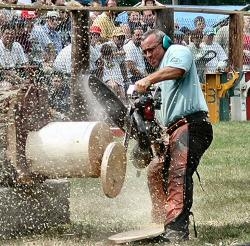220b-winter-2012/hw1
Appearance
Homework #1: Timbre-scapes
Due date: 2012.2.5 11:59:59pm (or thereabout), Thursday.
Reading
- skim through articles on chance music
Specification (part 1 of 2): Crafting Timbres with FM
- check out the FM synthesis/drone examples, in particular
- FM synthesis basics in ChucK
- fm-by-hand.ck : fm synthesis, 1::samp at a time
- fm2-sync.ck : more commonly used FM synth basis, setting sync to 2
- fm2-step.ck : yet another way to do FM synthesis in ChucK, via the Step UGen
- time varying Drone example (from class)
- Drone-1.ck : FM synthesis with SinOsc modulating a SqrOsc
- Drone-2.ck : the above with an added, time-varying "demon bunny" filter
- Drone-3.ck : layering three of the above, controlling each independently
- fm-mod.ck : interpolating FM synthesis parameters
- FM synthesis basics in ChucK
- using FM synthesis in ChucK, create the following:
- 3 different "static" timbres
- building blocks: oscillators, filters, etc.
- experiment with various parameters such as carrier frequency, modulator frequency, index of modulation, etc.
- 3 time-varying timbres
- building blocks: oscillators, filters, time-based control code
- can be a "drone" (but doesn't have to be)
- the time-varying process(s) should be somehow coupled to one or more of the FM/filter parameters
- next, take a timbre from above, and apply an ADSR envelope to "carve" out an attack, decay, sustain, and release
- test this by making some bleeps and bloops
- 3 different "static" timbres
Specification (part 2 of 2): Musical Statement
- explore and employ controlled randomness and chance, time-varying timbre and compose a musical statement
- macro-level structure/form: as an exercise, the piece should contain at least 3 sections (think about the flow and relationship between sections)
- think about how to leverage randomness to controllably generate passages...
- potential parameters that can be influenced by chance and trajectories.
- pitch
- rhythm
- meter
- timbre / synthesis parameters (e.g., FM parameters)
- dynamics
- tempo
- texture
- many, many others
- plan/score your composition somehow, pay attention to the above, and especially to the control of timbre
- take advantage of the timbre, time-varying control, and "bleepin'"/note/pitched event capabilities you've developed in part 1
- write ChucK programs to generate the different passages/sections/layers; for each, run/record the program multiple times, tweak parameters, and choose the best result for each part.
- put them together in audacity/ardour, or a bigger ChucK program (final audio file - wav)
Deliverables
turn in all files by putting them in your Library/Web/220b/hw1/ directory, and then linking to them from your Library/Web/220b/index.html - email Ge and Spencer with your hw1 URL
- 1) your static timbres (part 1): 3 chuck files
- 2) your time-varying timbres + bleeps/bloops (part 1): 3 chuck files + 1 bleepin' chuck file
- 3) your musical statement (part 2): chuck files + final mix (.wav file)
- 4) a short README text (readme.txt) file that:
- conveys your ideas/comments in constructing each program
- contains instructions on running your programs
- describes any difficulties you encountered in the process
- 5) your index.html should link to these files (optionally, you can include your README directly in your index.html)

